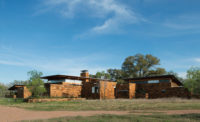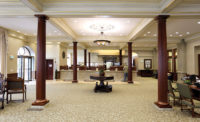How did you first develop an interest in architecture?
AC: I’ve always found a lot of joy in designing and drawing and sharing that with others, and when I was in college I studied architecture to expand on that. It was then that I realized that architecture is more than engineering buildings. It’s a chance to create harmonious and nurturing spaces for people to inhabit. It always amazes me how spaces can shape the lives of those within them, and for me, human interaction with spaces and buildings is much more important than the buildings themselves. I always wanted to be an artist, and architecture is just an expansion of that and one that offers stability.
What were some of your first design experiences as a professional or as a student?
AC: When I first started studying architecture, I took an architecture photography class. Interestingly enough, I seemed to be the only person who included people in my photographs, instead of just the buildings. That’s what really led me to the realization that design doesn’t come to life until people are added.
How often does your firm use stone in its designs?
AC: We actually use stone in bathrooms and kitchens in almost all our projects!
How would you describe your firm’s design philosophy?
AC: We focus on simple and beautiful spaces that create supportive and nurturing environments.
What’s a project that you have done with stone and/or tile that you’re proud of, talk about it a bit:
AC: We did one project for a friend of mine on Fifth Avenue, where we renovated his bathroom with beautiful textured Carrara marble. Of course Carrara is beautiful, but my friend is blind, so for him, it wasn’t just about appearance. He wanted something that created a unique, nourishing experience for him, and the texture in this stone provided a way for him to incorporate an interesting aspect to his space.
How do you go about choosing stone for a project?
AC: Usually I love to recommend white marble, like Calacatta or Carrara or Thassos. Crema Marfil and travertine are also some of my favorites. For me, though, it’s all about what the client wants and what they’re drawn to. My role is to help direct them to the best option for their wants and needs. I usually go for large formats like 12 x 24.
What are some of the trends you are seeing nowadays in regards to use of stone, tile, quartz, etc.?
AC: Large format and large hex mosaics. Honed finishes, butt-jointed applications. Thin, ¾-inch material for countertops and vanity tops.
As far as tile, what colors do you like to use? Are neutrals the most popular or has it been expanding to other colors? If so, what colors?
AC: Neutrals are the most popular still. Beige is coming back into style. People are getting more tired of gray. People want to see more wall and less tile. I like to use white marbles and beiges and warm grays.
What tile do you like the look of most and why? (Industrial, stone, wood, etc.)
AC: I like travertine. I like the earthy, neutral quality and it has a nice serene look but can still be dramatic.
Do you use a lot of quartz? If so, what do you like about it? What is difficult about it?
AC: Yes, I use a lot of quartz - almost always for kitchen countertops. I love the durability, especially now that there are more and more choices that look like natural stone. Unfortunately, it does still look manmade.
Do you prefer natural stone to engineered? Why or why not?
AC: No, I don’t. It depends on the situation. Kitchen countertops, I almost always recommend manmade because of the durability and even for bathrooms, especially children’s bathrooms, I recommend porcelain, which is manmade. For master bathrooms, I prefer stone. I do prefer stone in general, but I don’t always recommend it for the clients.
What advice would you offer to a young architect?
AC: Get all the experience you can! I’ve always worked for small companies, so I love working on projects from beginning to end and being involved with every part of the process. I really gained a lot of experience that way. Also take care to really learn from your mentors and other architects. They have so much knowledge to share!





